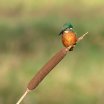Lets start with this Female Kingfisher. The weather was terrible and with dog walkers everywhere she was never settled enough to come close. With her being a little twitchy that day I dare not move too much to improve the angle and the background. Not wanting to come home with an empty memory card I fired off a few shots not hoping for much. My 7DII and 100-400 were certainly straining. With the shutter at 1/250th and the lens at f6.3 the lowest I could get the ISO was 2000. I hadn't noticed that my IS was switched off too so shooting at 400mm handheld left a tiny bit of motion blur. So with ugly bokeh, a slightly blurry image and noise introduced by the high ISO this image was going to need a little effort.

After a couple of minor tweaks in Lightroom such as applying lens correction and a tiny adjustment to exposure, highlights and shadows I opened the image in Photoshop. I do not carry out any sharpening in Lightroom on images like this as I prefer to be selective and do it in Photoshop. Same goes for noise reduction. When I first started in digital, noise reduction was a bit of a swear word. People hated the thought of smudging detail just to get a clean looking image. We didn't do it in the days of print so why do it now. Back in the print days we embraced the grain, but in digital it is for some reason less pleasing. Being selective in our use of noise reduction often means we can have a clean looking image and leave the detail in our subject. I always begin the process by selecting my chosen crop. Some of the techniques I use to sharpen and remove noise can be a little processor intensive, so no point in spending time working on parts of an image you are going to throw away.

Once cropped any noise will be even more visible. You can also see when massively zoomed in the softness caused by the low shutter speed. In reality I would never crop this much except to check details etc.

Sharpening the Kingfisher and stick are my first tasks here. I want to be selective as sharpening everything will only sharpen the noise. Noise is a lot less visible in areas of detail, the in focus areas, than it is for the background which is usually out of focus. While Photoshop has many different methods for making a selection the one I have chosen for this, and many other images, is the wonderful focus area selection tool. This selects any pixels it thinks are in focus and usually does a wonderful job. Sometimes I need to use the quick selection tool to refine the edges a little such as the small area on the beak and back of the head as seen in this image.

With the kingfisher is selected I can start to apply some sharpening. There are many methods of sharpening very well documented throughout the internet so I will not go into those. I always do my sharpening on a duplicate layer so if needed I can adjust the level of the effect by simply using the opacity slider. In the case of this image I am using the shake reduction filter to sharpen the image.

I also used an excellent plugin from Topaz, the Topaz Clarity filter, to try and bring out a little more detail in the feathers without adding to any noise. Again, this was on the same layer so I could tweak the effect with the opacity slider.

With sharpening complete I then flatten the image back to the one layer. For the noise reduction I only want to work on just the background so invert (Shift+CTRL+I) the selection. This means everything except the kingfisher and stick are selected. Now that I am just working on the out of focus areas I can happily apply high levels of noise reduction. While the tools in Photoshop are very good, I prefer to use the excellent Topaz De-Noise. If opened from within Photoshop it will respect any selection already made and only apply its magic in your chosen area. The preview does not reflect this as you can see here but when you apply the filter and return to Photoshop's edit screen you will see the bird remains untouched. In this case I used very heavy noise reduction.

While the background is clean I still think it is a little distracting, so I decided to blur it some more. First I needed to click on the quick selection tool in Photoshop and use its refine edge options. I start by pulling the shift edge slider all the way to the left then adjust the feather slider a little so none of the bird is visible outside the white area.

This leaves the selection line a few pixels away from the bird which is what I wanted here.

To soften the background there are many methods and blur filters available in Photoshop. I have chosen the lens blur filter here and set it to quite a high level. As you can see, it works very fast and gives a nice effect.

All that is left are couple of tweaks to the contrast, vibrance and brightness to fit my taste and I have my final image. It is not perfect but in just a few minutes I have an acceptable, at least for web, kingfisher shot. The above sounds complicated at first but once done a couple of times it really can be achieved in under 5 minutes to most images of this type. As with any task in Photoshop, there are hundreds of methods of getting to a final result. I am not for one minute suggesting my method is perfect, just one that works well for me.
As mentioned above, as well as Photoshop CS I also used some excellent tools from Topaz Labs. They are available for a 30 day free trial here - https://www.topazlabs.com/






























